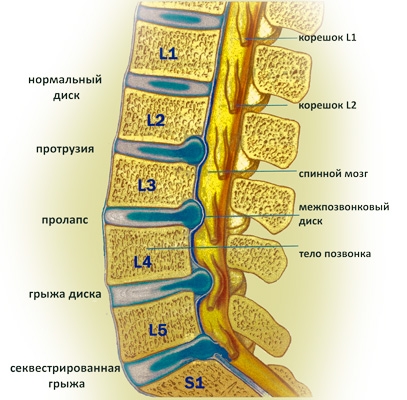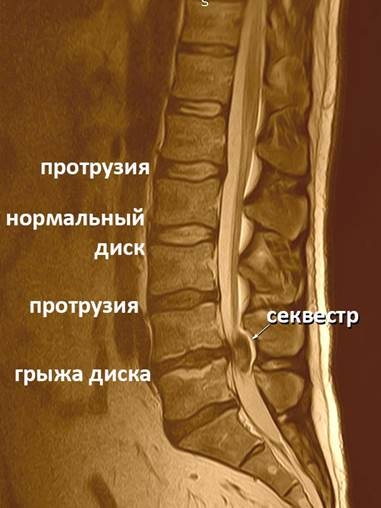Degenerate disc lesions
 |
Disc protrusion (1-3 mm) is associated with a decrease in elasticity of pulpous nucleus, while the elasticity of fibrous ring is preserved. Treatment for disc protrusion is usually conservative – massage, gymnastics, physiotherapy. Treatment should be followed with lifestyle modifications, including daily physical exercises, walking, jogging, swimming, and most important – weight control to avoid excess loads on the spine. |
Disc prolapse (3-6 mm) is associated with reduced elasticity of pulpous nucleus and fibrous ring leading to the reduction in the disc height, loss of congruence in facet joints and chronic back pain. Treatment is usually conservative – massage, gymnastics, physiotherapy. Also, paravertebral blockades (with dexamethasone, or Diprospan) or radiofrequency ablation of nerves in facet joints are performed. The latter provide an anesthetic effect so that patient could wait for spine restabilization. Effect of Diprospan injection lasts for 3-4 weeks, and effect of radio-frequency ablation could last up to 6 months. In a case of disc prolapse patients should have MRI with the interval of several months to monitor spine condition.
Disc herniation (with rupture of the fibrous ring) can occur after disc prolapse as the next stage of the disease, or even inadvertently, without any previous disc lesions. Frequently patients can describe exactly when disc herniation occurred. They feel a stroke in the lower back, followed by persistent leg pain. Disc herniation in some cases causes severe pain, so patients have to take an enormous quantity of medications and later turn to a surgeon for help. In other situations, if herniation has favorable localization, patients have no symptoms at all. Sometimes even spontaneous resolution of disc herniation is possible, and in 3-4 weeks after the diagnosis, there is an only small mark at the site of previous herniation.
If medical therapy gives no effect after 4-8 weeks, and pain is persistent, with only short-term effect from painkillers, the patient should be referred to a surgeon. But if life quality comes back to normal or improves to the extent, when the patient can return to normal activities, medical therapy should be continued.
Sequestration is the part of disc herniation, the fragment of the pulpous nucleus, which separated from the disc and located in the spinal canal, compressing nervous structures. Usually, sequestration locates not far from the place of origin, but it could migrate under the posterior longitudinal ligament upward or downward. Sometimes it resembles disc herniation of adjacent vertebra, leading to misdiagnosis and difficulties in procedure planning. Large sequestration can result in spinal stenosis and cause the disturbance in lower limb movements and impaired function of the pelvic organs. protrusion herniation sequestration |
 |
An osteophyte is a newly grown bone. Osteophytes locate most frequently on the border between the bone and the cartilage. Osteophytes in the anterior spine are benign since they do not compress nerves. Posterior osteophytes often locate very close to the nerve roots but do not always cause nerve compression.


